Originally posted on July 18, 2021
I’ve wanted to write this post for a while now because I think it’s really important for traders, especially new traders. So many times on various forums I see new traders asking what to do about a trade they have already put on. The questions typically fall into one of two categories: 1) My trade is in trouble, what do I do? or 2) When should I take off this trade? My response to these types of questions is: “What does your trade plan say to do?” and the conversation generally ends. This may seem like an answer that isn’t helpful but I think it actually is helpful. When someone asks a question like that, it’s tough to give a useful answer if you don’t understand the purpose of the trade and, more importantly, the risk tolerance of the trader. This is where a solid trade plan is important. A trade plan should lay out very clearly the goals of the trade as well as the risk management of the trade. When the trade is closed, the standard of evaluating the trade should be the trade plan. There is no one standard or criteria for success or failure that applies to everyone. Trades, ultimately, reflect the trader. What is a good trade for me may not be a good trade for you and vice versa. Your risk tolerance may be quite different from mine. But all of these things can be included into a trade plan built for a specific trade by a specific trader.
The time to consider what you do in a trade is before the trade is put on, not after. The market can move quickly and taking time to figure out what to do in the moment can lead to bad decisions. And while it’s perfectly reasonable to make changes to a trade plan, those changes should happen in between trades, not while a trade is on. Changing course mid-trade, in my experience, leads to more negative outcomes than positive. Could you get lucky and do well? Yes. But decisions made in the heat of the moment are usually based on the emotion of the moment. Our goal as traders is to be as mechanical as possible and to do that we need a solid plan that covers all situations before we enter a trade.
The Anatomy of a Good Trade Plan
Now that I’ve established the importance of a good trade plan, it’s fair to ask, “What’s in a good trade plan?” I will first attempt to describe the parts of a good trade plan and then look to an example. Here are the elements I consider to be vital to a good trade plan:
- Entering the Trade
- Profit Target
- Maximum Loss
- Maximum Time
- Adjustments
ENTERING THE TRADE
While this may seem really basic, you’d be surprised how many new traders don’t really think about this part. But setting up a trade is vital to the success of the trade. What is the structure of the trade? Where does each set of contracts start? At the money? In/Out of the money? Are the positional Greeks important? There is no one right answer here because there are so many different trades. But this shouldn’t be a pure guess. How you put on a trade should be intentional. If you can’t state this specifically, I strongly suggest taking a step back and think about why you think this is a good trade. I do not suggest blindly copying someone else’s trade (and I say this as one who shares all of my trades online. It’s not a bad thing to learn by what others are doing, but it’s really important that you understand what the other trader is doing and why. Putting on a trade without understanding the setup and goal is very dangerous. My standard for this (and for the entire trade plan) is that you need to be able to explain what you are doing and why to someone else clearly. If you can’t do that, you most likely don’t really understand it yourself. This is one of the reasons I put my trade reviews online. I force myself to explain what I’m doing.
Another very important concept in this part of the plan is trade size. Trading is, ultimately, a risk management business and the first element of risk management is the size of the trade. Many traders will tell you that the worst losses they took were either put on too large or were allowed to grow too large via adjustments. Knowing the initial size of the trade as well having a risk cap on the trade is a critical step to keeping losses under control. You can’t lose what you don’t risk.
PROFIT TARGET
The goal of every trade should include profit (or at least the possibility of profit in the case of a pure hedge). But what’s important here is to define specifically what the profit goal is. “This trade should make a profit” is not good enough. The plan should state a specific goal. That goal could be a raw amount or a % of the size of the trade. This helps answer part of the question “When should I take the trade off?”. If you are asking this question when a trade is profitable, you either did not set a profit target or are second guessing yourself. Neither is good in the long term. Again, the time to change your plan is between trades, not while they are on and the market is moving.
MAXIMUM LOSS
This is probably the toughest plan element in terms of execution. But you need to know when enough is enough. Even with the best plan, not all trades will succeed. Losses are a part of the business and taking them properly is critical to successful trading. It’s very easy in the heat of the moment to talk oneself into making more adjustments to try and save a trade and avoid taking a loss. And sometimes it can work. But many times, this is where bad losses happen. The one trade that took out 3 months of profits. I speak from first-hand experience. This is another critical part of a risk management strategy. This is why you need to know up-front how much you should risk on a given trade. As I stated above, size the first element of risk management but a close second is the max loss. If your trade hits or exceeds the max loss of the trade plan, especially at an adjustment point, it’s time to close the trade and move on. The ability to move on from a trade that didn’t work out is very important. It’s so important that I did a separate blog post on it called “Pets vs Cattle“. I use this analogy all the time to remind myself to take a loss before it becomes a bad loss. I don’t always succeed but I continue to work on this part of my trading as it does make me better. But what’s important here is that in order to execute properly on a max loss, it needs to be explicitly defined in the trade plan.
MAXIMUM TIME
This is an element that I think gets overlooked by many traders. Unlike stock trading, options trading is very sensitive to time because, unlike shares, options contracts expire. Some specific trading strategies, like the wheel, can go all the way to expiration. But in many options trades, the risk/reward changes significantly as expiration gets closer and that should be reflected in a trade plan. The kinds of trades I do work better if I stay away from expiration week or “Gamma Week” as it is sometimes called. For more examples of why this can matter, feel free to read a blog post I did on this earlier called “Why I Avoid Expiration Week“.
Bottom line: It’s important to understand the risk of a given trade as expiration approaches and factor those risks into a trade plan. This may mean you have a point where you simply exit the position by a given point in time regardless of profit or loss because the risk/reward has changed enough that the trade no longer makes sense. One way to judge this is to ask yourself “Would I put this trade on as a new trade given the risk/reward?” If the answer is no, you should exit the trade.
ADJUSTMENTS
This can be the most complicated part of the plan but it is vitally important. But I will start with this statement: Adjustments are not required in all trades. A valid trade plan can simply have exit points based on the initial entry to the trade. Doing so makes the trade plan and execution easier. The downside is that you may miss out on some potential winners. There is no perfect answer here. But if you are going to adjust, you need to have a set of conditions that would cause you to adjust, as well as know the adjustment up-front. When the market is moving against your position is not a time to figure out what you need to do. Ideally you have one specific adjustment per condition. You might have two but in that case, you should have specific criteria to help you decide which adjustment to deploy. And when first starting out with adjusting, keep it as simple as possible to help you execute properly. You will have time to make adjustments to your plan as you trade more (but only in between trades). The adjustments part of the plan should have specific conditions that trigger an adjustment. These conditions can be the price of the underlying, or a certain Greek value like delta. But timing is really important when it comes to adjusting. Knowing when to adjust is more critical than how to adjust, in my opinion. Adjusting too early can lead to reversals that kill your trade. Adjusting too late can lead to throwing more money at a bad situation and taking larger losses than you planned. The speed of the market can certainly affect how you may adjust. When the market is moving very fast, especially on the downside, an adjustment involving multiple legs may not be possible as prices are just moving too quickly. These situations are rare, but they happen and a trade plan needs to account for them. Sometimes all I can do is grab a put and hang on. But that’s really not specific enough. How many puts? Which puts? What expiration? How long do they stay on? All of this must be part of the trade plan.
Another important element here is to know when not to adjust. Did the market just open? Maybe it’s a good idea to wait a bit and see if it reverses. Is the trade profitable? Maybe it’s a good idea just to take it off and move on to the next one. How many times have you adjusted this trade? Maybe it’s a good idea to just take the loss and move on. How long has the trade been on? Does the trade still have time to work post-adjustment? As you can see, this part can get complicated, and some of these elements you will learn as you trade more and get more experience.
An Example of a Good Trading Plan
So now that I’ve talked about the elements that make up a good trade plan, I want to show an example. PLEASE NOTE: This is just an example of a trade plan. This is not a trade recommendation. I have no idea of your level of expertise, risk tolerance, account size, etc. The goal here is show how one might put the elements of a trade plan together. I hope I can show that here. This particular trade is one the trades I’ve done regularly over the past year or so with reasonable success.
TRADE: 23-day SPX Narrow Calendar
ENTRY: I enter this trade near the end of the trading day on Wednesday. This is a trade that starts at the money with the shorts 23 days out. Where I put the longs depends on the VIX at the time I open the trade.
- VIX under 12: The longs go 14 days away from the shorts*
- VIX between 12 and 15: The longs go 7 days away from the shorts*
- VIX between 15 and 20: The longs go 5 days away from the shorts
- VIX between 20 and 25: The longs go 3 days away from the shorts
- VIX over 25: Do not put on the trade due to very high volatility.
*Not really narrow at this point, but a standard calendar. Rules still apply.
The reason for this is that the longer the distance between the shorts and the longs, the more the trade is exposed to volatility (position Vega). The higher the volatility, the less Vega exposure I want for it. I understand that in exchange for less Vega exposure, I get less Theta decay. That’s a trade-off I’m willing to make.
As for size, I want to risk around $3000 on the trade.
If VIX is up more 2 points or more on entry day, I will probably delay entry until Thursday. If volatility keeps going up, skip the week and wait.
PROFIT TARGET: The profit target for the trade is 10% of the original risk of the trade. Within the first week I’m willing to take 8% I bump the target up at 6-7 days in the trade.
MAXIMUM LOSS: My max loss for the trade is 15% of the the original risk of the trade. In the first two days, it’s 12%.
MAXIMUM TIME: I want to be out of this trade no later than Monday of expiration week.
ADUSTMENTS:
Under normal conditions, I adjust if the trade crosses either expiration break-even or if the the market appears to close within 5-10 points of an expiration break-even. I’ll go on the lower end of the range mid-week, I adjust closer to 10 going into a weekend. The adjustment here is to add a new set of calendars equal to the number of calendars put on originally about 30 points past the break even point. Optionally, I can move half of the calendars to the new place to keep the risk the same instead of doubling up.
Once in a double, my new adjustment points are the centers of each calendar. If the underlying crosses either one, the adjustment is to take off the other structure, returning back to a single calendar. From there I could go back to a double if desired.
I usually don’t go to a double more than twice and at that point will consider just closing. Three times would be the absolute most and only then if I like the graph going into the 3rd double.
EXCEPTIONS:
- If the underlying moves down more than 1.6 standard deviations in a day and an adjustment is needed, I consider buying a put to flatten the deltas about 80%.
- I usually buy the put in the later expiration of the calendar or later if needed. The expected life of the put is 20% of the time left on it at the time it was bought.
- I keep the put until the underlying gets back to the center of the nearest calendar or if the expected life is exceeded. If the expected life is hit, I could roll it out for more time or just sell it.
- The goal of the put is to just keep the trade from getting out of hand in a fast down market.
- If the trade is up at all at an adjustment point, I will close the trade entirely.
- If the trade needs adjustment before the first weekend, I will consider closing the trade. This decision is based on the graph at the time (experience counts here)
This is an example of a trade plan that covers lots of cases. If for some reason the plan can’t be executed due to something unexpected, in my experience, it’s best to close the trade and re-evaluate the plan. This happened to me once on an SLV trade where there were no options available to do my upside adjustment. They just weren’t on the market. I hadn’t accounted for that in my plan so I just closed the trade. This is part of the learning process.
To a new trader, I can easily see how this can be overwhelming. There are trades that can have simpler plans. Most of the complexity is in this trade is in the adjustments and, like I said, not all trades need adjustments. But the goal is to show what I think is a good trading plan. Every trade needs a plan. Then the trick is to properly execute the plan. As the famous boxer Mike Tyson once said, “Everyone has a plan until they get punched in the face”. But building a plan and executing that plan is how to become consistent. The important thing with a new trade is to start small. One-lots are perfectly fine. Keep the risk under control while developing and executing your plan.
As usual, I’d love to hear what you think about trade plans. Feel free to reach out to me directly at midway@midwaytrades.com
This content is free to use and copy with attribution under a creative commons license.
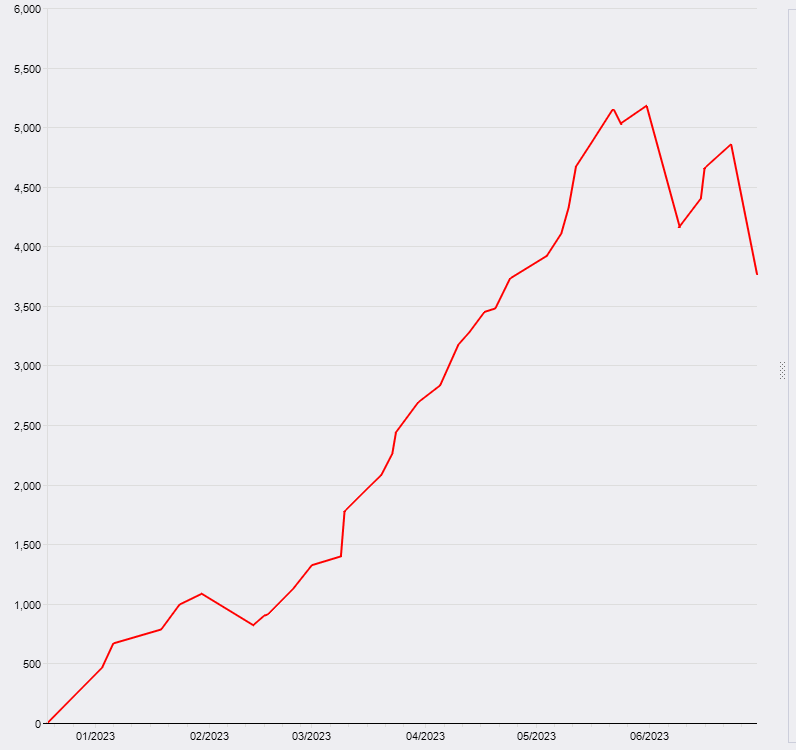

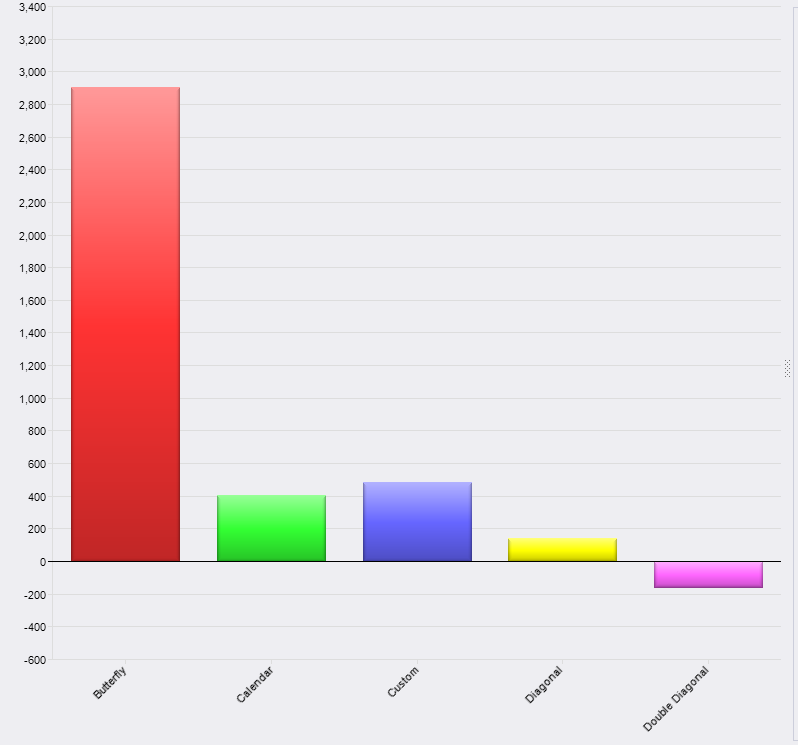
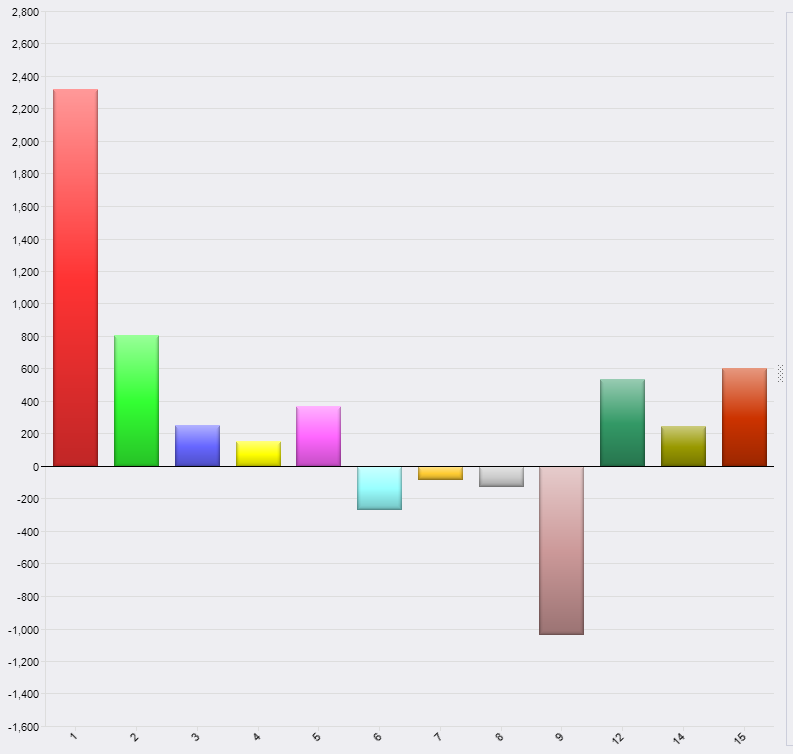
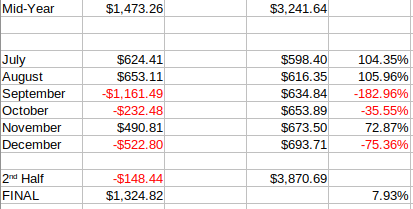
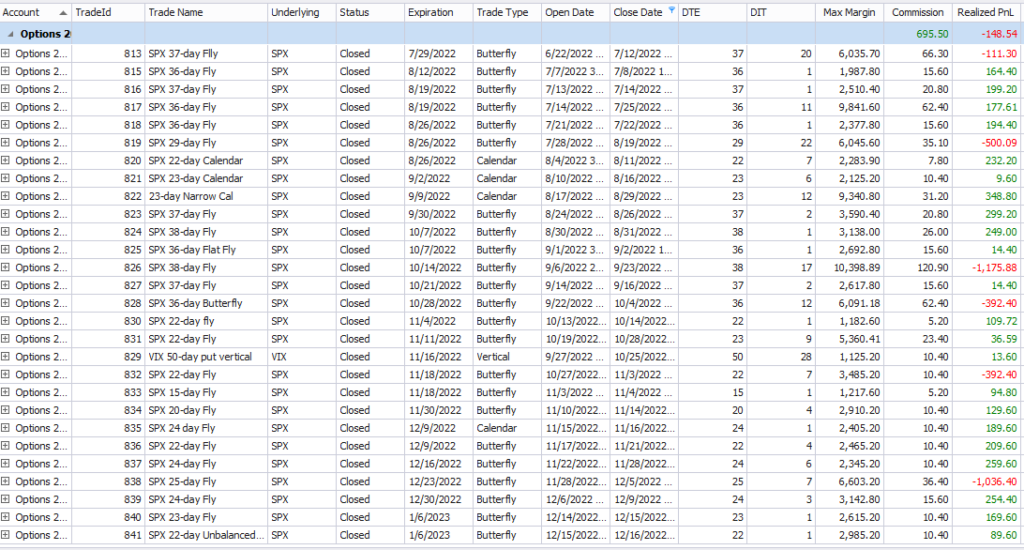
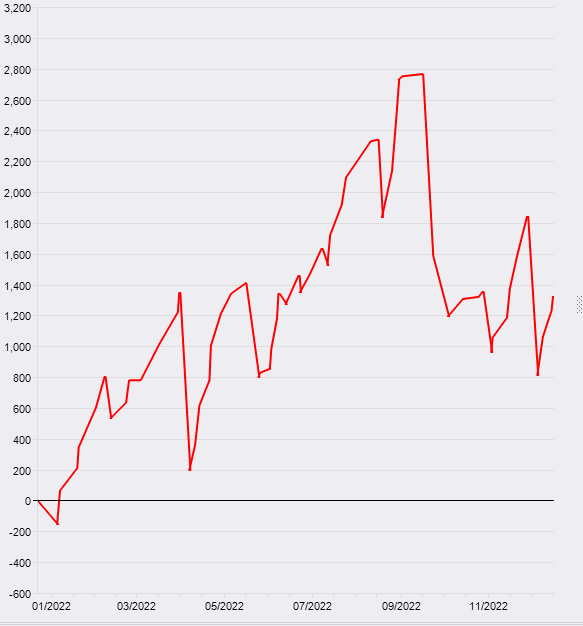
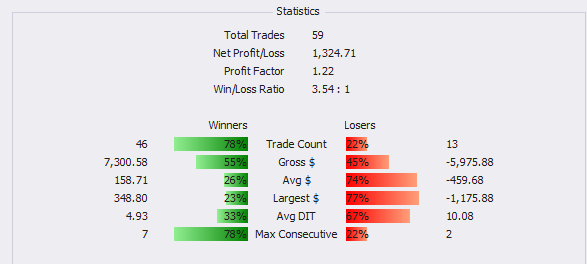
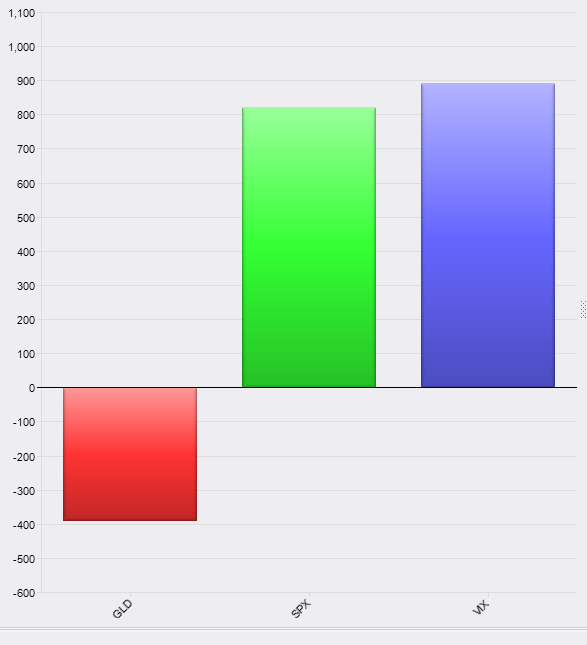
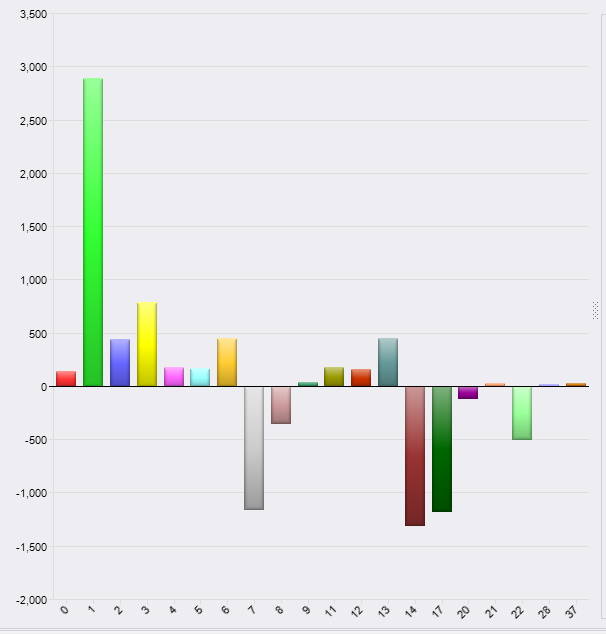




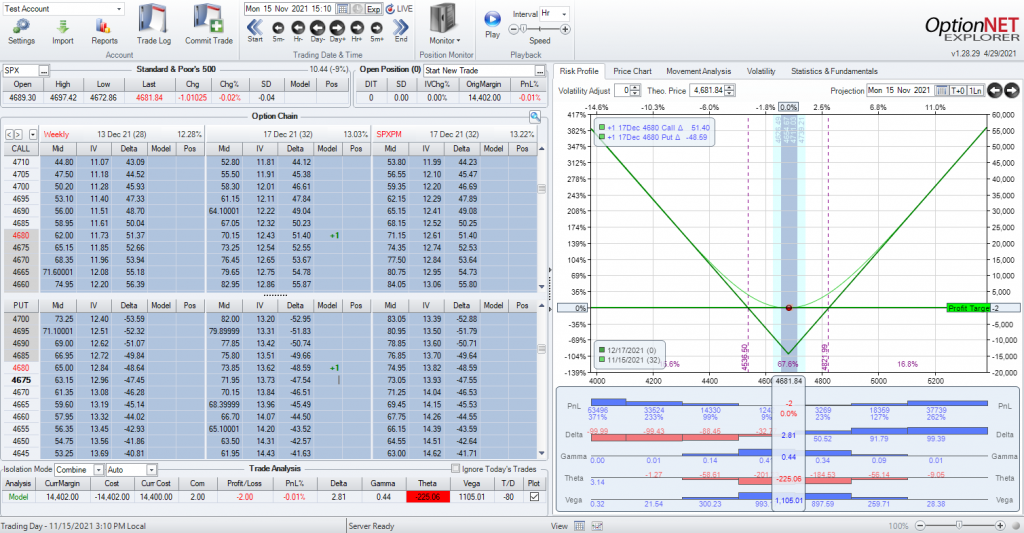
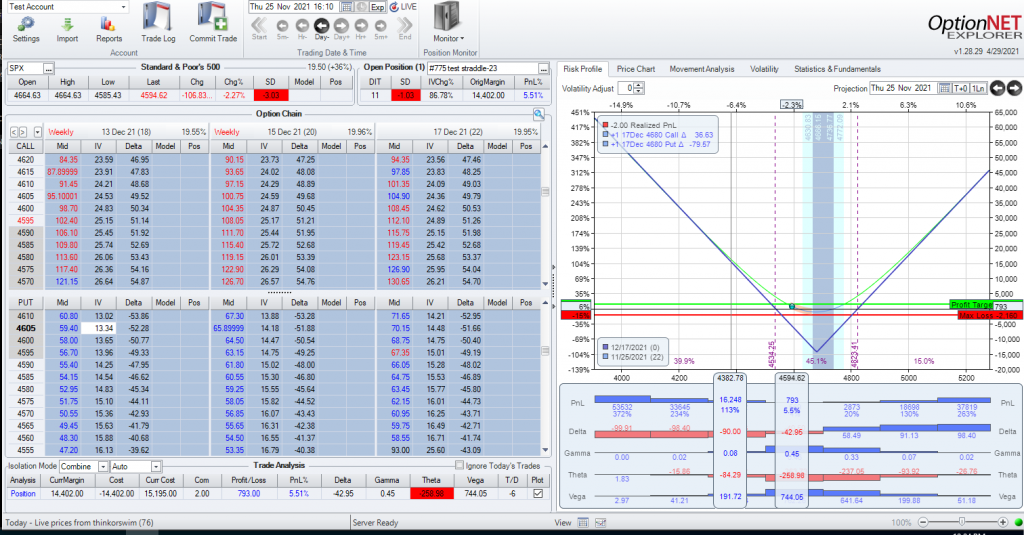
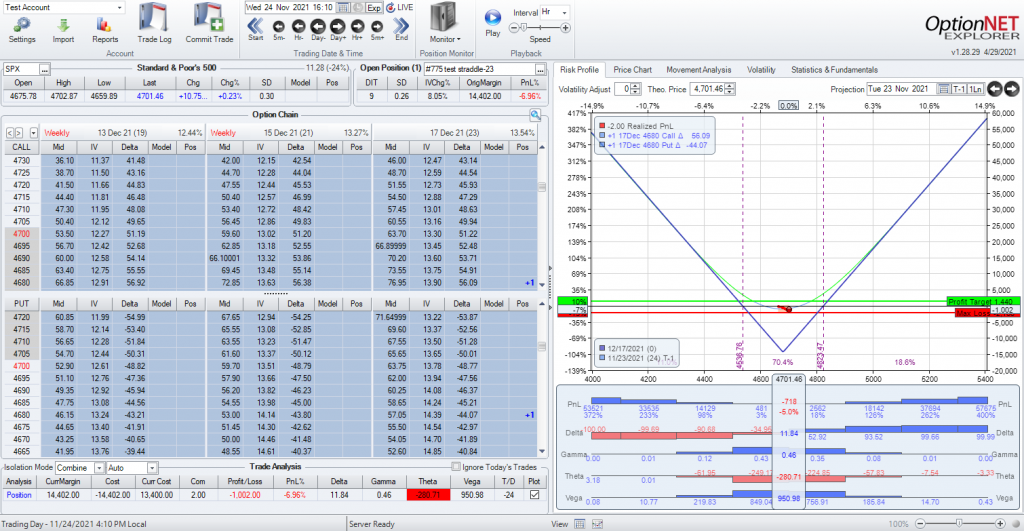
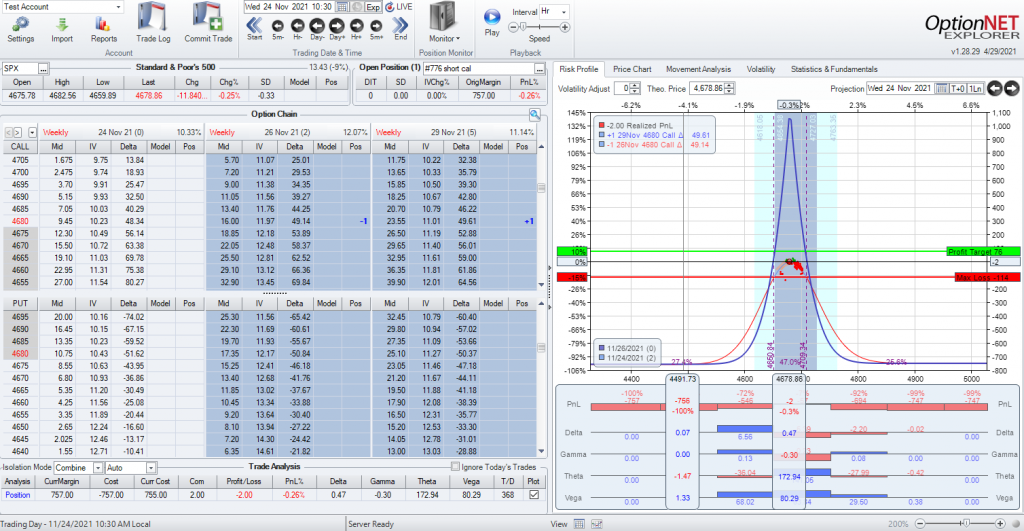
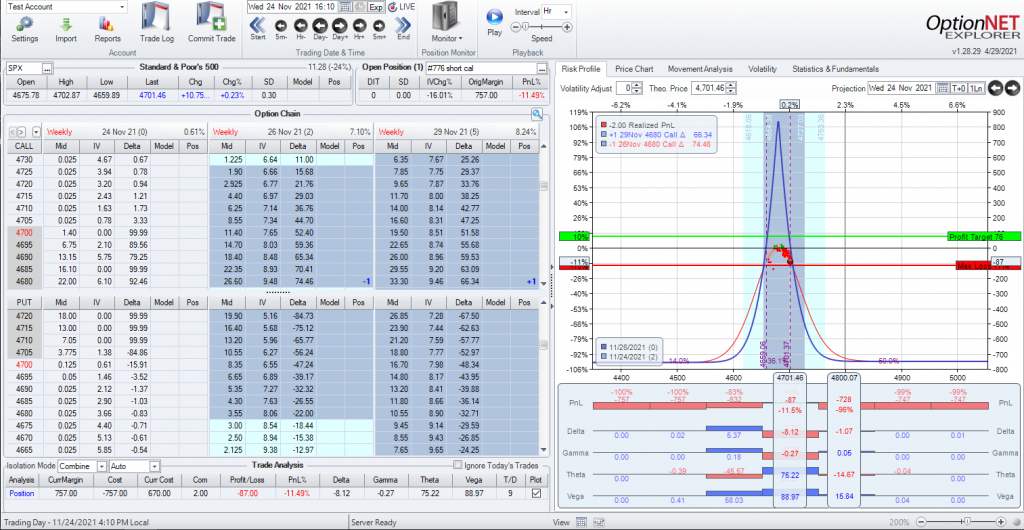
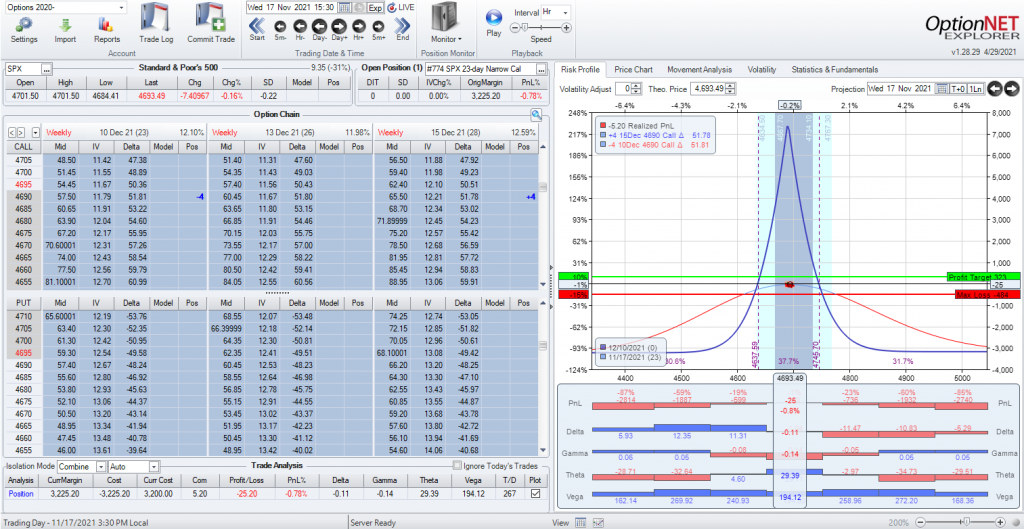
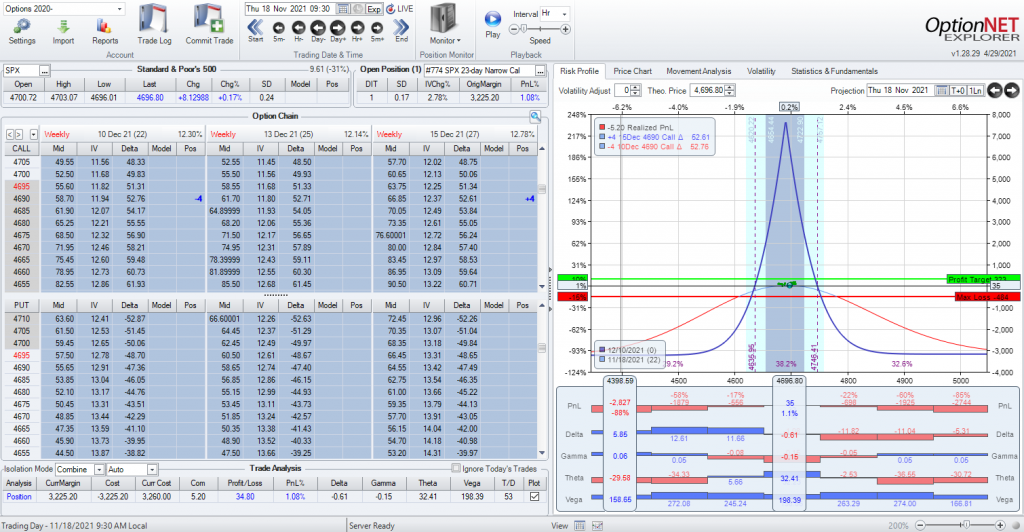
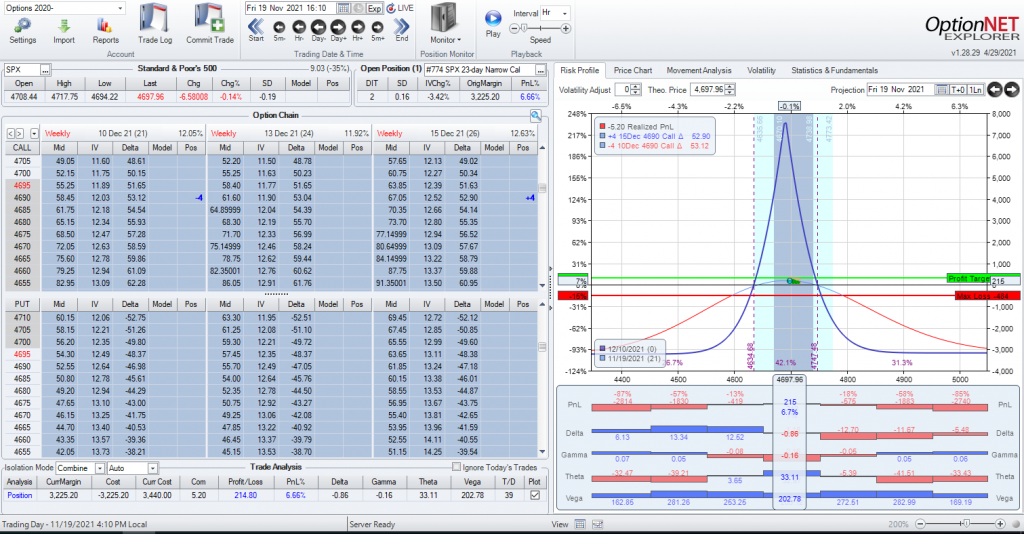
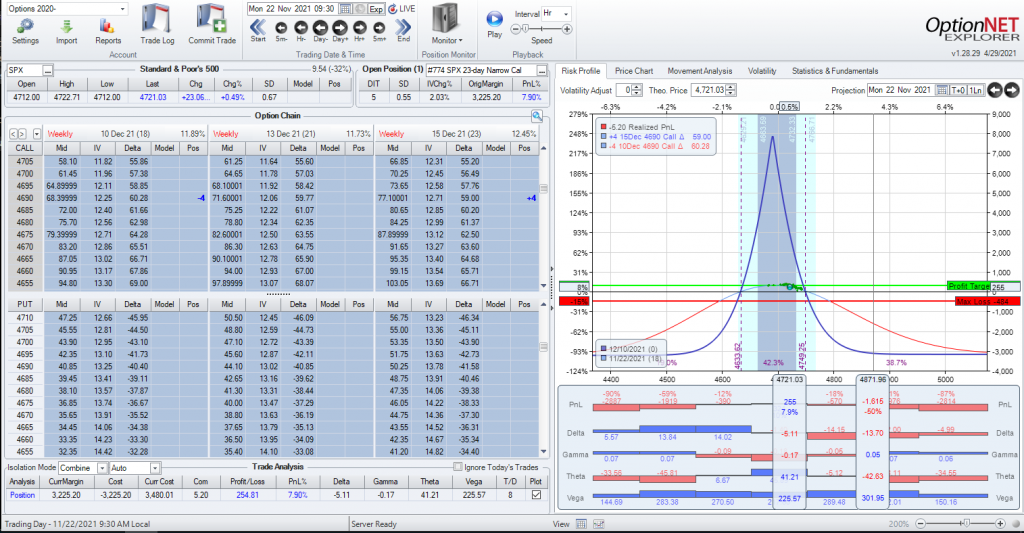
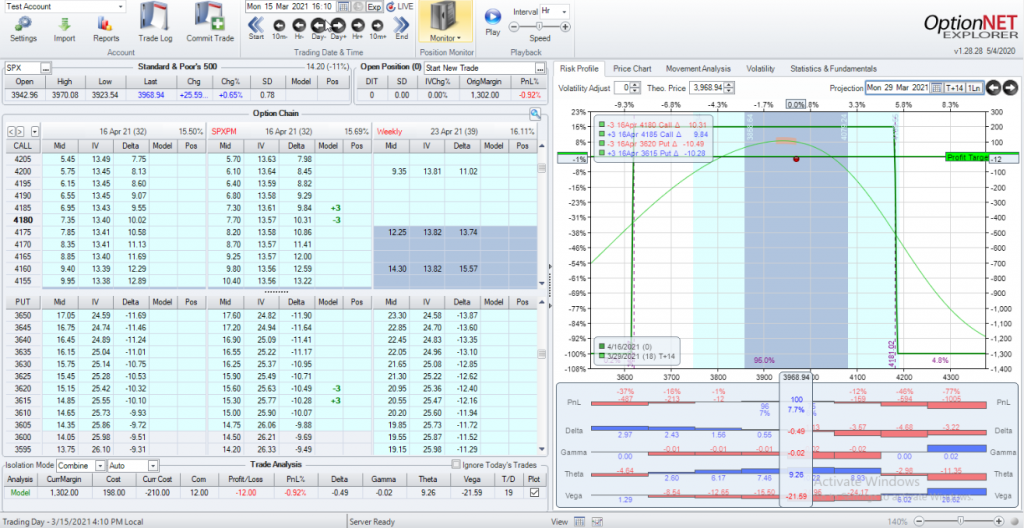 The slope is starting to get steeper as you move towards the edges, especially on the upside. This means that if SPX moves in that direction, you will become more directional as delta and gamma increase and each move up hurts the trade more. The downside certainly looks better but keep in mind as well that a sharp move to the downside will spike volatility and so the curve won’t be quite a generous ad the graph currently shows. So if you let the trade go to either side, you may have some white knuckles while you are holding on. Alternatively, you can adjust but most of these adjustments reduce the total credit of the trade which, in turn, lowers the amount of the win. If you over-adjust this, you may end up with no credit left and, at that point, the trade will just lose.
The slope is starting to get steeper as you move towards the edges, especially on the upside. This means that if SPX moves in that direction, you will become more directional as delta and gamma increase and each move up hurts the trade more. The downside certainly looks better but keep in mind as well that a sharp move to the downside will spike volatility and so the curve won’t be quite a generous ad the graph currently shows. So if you let the trade go to either side, you may have some white knuckles while you are holding on. Alternatively, you can adjust but most of these adjustments reduce the total credit of the trade which, in turn, lowers the amount of the win. If you over-adjust this, you may end up with no credit left and, at that point, the trade will just lose.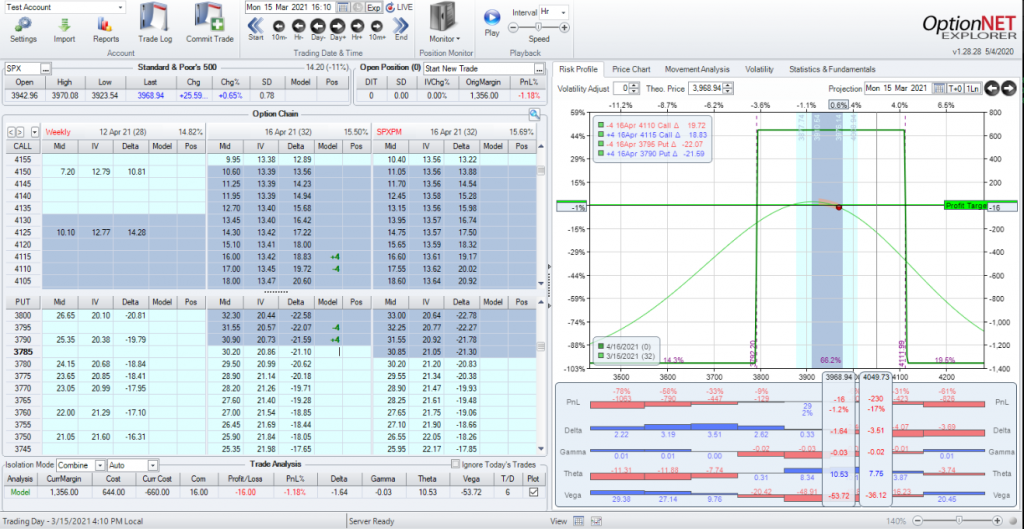 In this trade, I’m selling around a .20 delta on each side. In this case I sold a 4-lot to try and keep the risk close to the other trade. In this case, it’s a bit more at $1356. However, my credit is now $660 (or $644 after my expenses). This puts my risk/reward at about 2x. I certainly like this better. But the downside is my range is now 140 points on the upside and 176 points on the downside. That’s a significant difference and it brings my probability of profit down to about 66%. On the positive side, my theta is better at about $10.50/day at the beginning of the trade. If I had to trade an Iron Condor, I like this better than the first one. However, this puts your risk/reward closer in line with other trades that I like better.
In this trade, I’m selling around a .20 delta on each side. In this case I sold a 4-lot to try and keep the risk close to the other trade. In this case, it’s a bit more at $1356. However, my credit is now $660 (or $644 after my expenses). This puts my risk/reward at about 2x. I certainly like this better. But the downside is my range is now 140 points on the upside and 176 points on the downside. That’s a significant difference and it brings my probability of profit down to about 66%. On the positive side, my theta is better at about $10.50/day at the beginning of the trade. If I had to trade an Iron Condor, I like this better than the first one. However, this puts your risk/reward closer in line with other trades that I like better.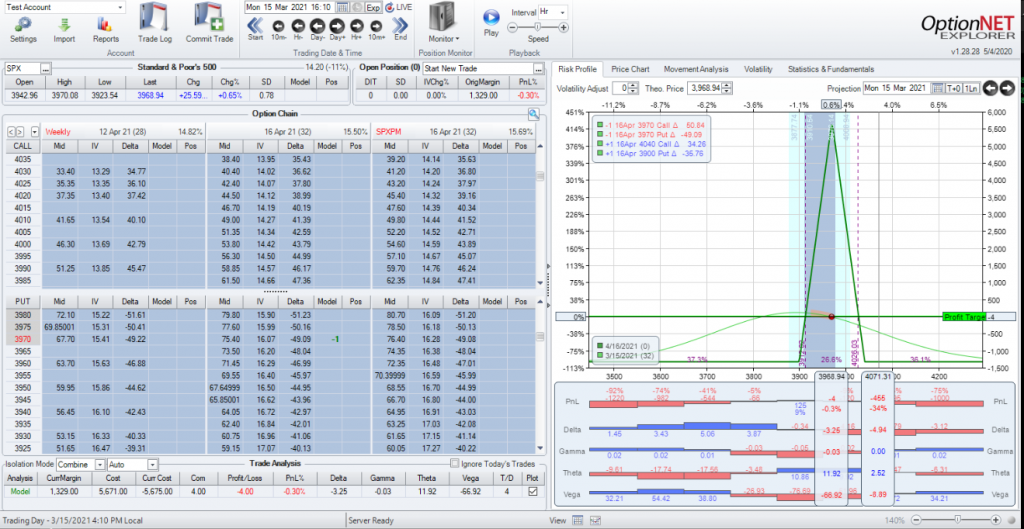 With this trade, my range is very narrow compared to the Iron Condors. And, with this trade, the width of the structure is determined by the width of the spreads themselves rather than the distance between the shorts since that distance is zero. So why do I like this trade better? It’s not the range as, in this case, I have around 70 points in each direction which gives me an expiration probability of about 26%. But, remember, I have no plans on staying to expiration week, yet alone expiration day, so the expiration probabilities don’t mean as much to me. I’m far more concerned with the next week or two. Ideally, I’m out of this trade in 2 weeks or less. My total risk is between the two Iron Condors at about $1330. but I took in $5671 in credit. That flips the risk/reward ratio over to the reward side. Now, with any butterfly, the goal should never be to get the maximum profit as the underlying would have to expire on the exact short strikes which is akin to winning the lottery. But, I’m usually trying to make about 10% on these trades in far less time and having that large total credit gives me plenty of room to reach it, even if I had to reduce the total credit with adjustments. And if I was actively managing an Iron Condor, especially the lower probability example, if the underlying moved 70 points in either direction, I’d probably have adjusted the Iron Condor as well which means the work to maintain each is similar given similar market conditions. I also like the starting Theta of about $12/day even though my total risk is a bit lower than the lower probability Iron Condor.
With this trade, my range is very narrow compared to the Iron Condors. And, with this trade, the width of the structure is determined by the width of the spreads themselves rather than the distance between the shorts since that distance is zero. So why do I like this trade better? It’s not the range as, in this case, I have around 70 points in each direction which gives me an expiration probability of about 26%. But, remember, I have no plans on staying to expiration week, yet alone expiration day, so the expiration probabilities don’t mean as much to me. I’m far more concerned with the next week or two. Ideally, I’m out of this trade in 2 weeks or less. My total risk is between the two Iron Condors at about $1330. but I took in $5671 in credit. That flips the risk/reward ratio over to the reward side. Now, with any butterfly, the goal should never be to get the maximum profit as the underlying would have to expire on the exact short strikes which is akin to winning the lottery. But, I’m usually trying to make about 10% on these trades in far less time and having that large total credit gives me plenty of room to reach it, even if I had to reduce the total credit with adjustments. And if I was actively managing an Iron Condor, especially the lower probability example, if the underlying moved 70 points in either direction, I’d probably have adjusted the Iron Condor as well which means the work to maintain each is similar given similar market conditions. I also like the starting Theta of about $12/day even though my total risk is a bit lower than the lower probability Iron Condor.